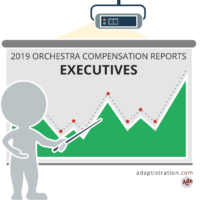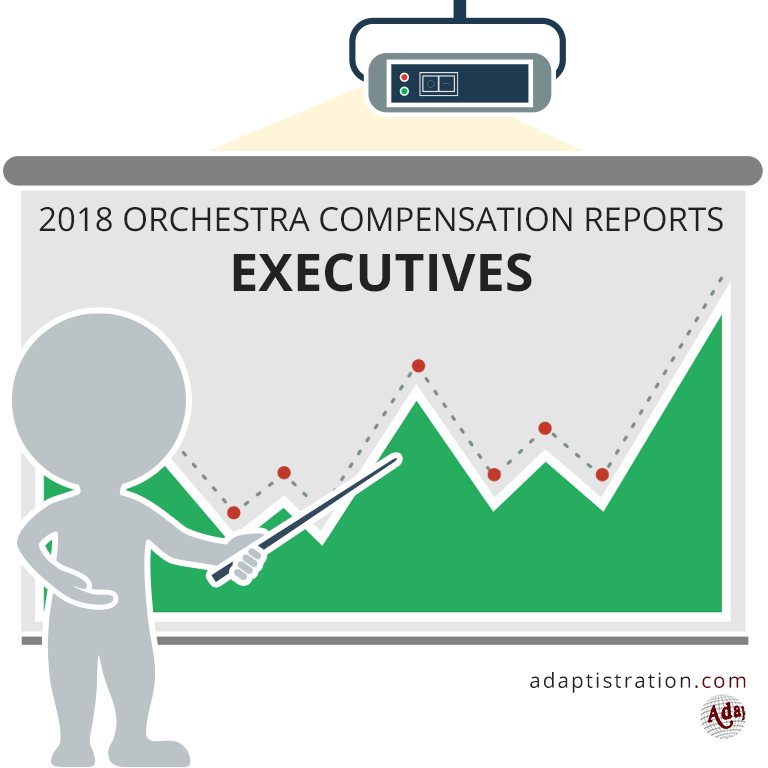When it comes to executive compensation, the 2016/17 season was still seeing averages skewed thanks to the ripple effect from a larger than normal number of CEO vacancies and interim appointments among the higher paying positions. Nonetheless, even when including those lower than normal figures, the average executive compensation still managed to increase by 2.88 percent.
The Information
In order to provide information that is as accurate as possible, info from the 2016/17 season is gathered from the following sources:
- Executive compensation figures were obtained from their respective orchestra’s IRS Form 990 for the 2016/17 concert season.
- Total Expenditures were also obtained from each respective orchestra’s IRS Form 990 for the 2016/17 concert season (due to their relationship within a larger performing arts structure, Total Expenditure figures for National Symphony, Atlanta Symphony, and Dayton Philharmonic are not as readily available).
Adaptistration makes no claim to the accuracy of information from documents compiled or reported by external sources. If you have reason to believe any of the information is inaccurate or has changed since reported in any of the above sources and you can provide documentation to such effect, please feel free to use the following form to submit a notice.
Did you know? Direct links to most of the orchestra’s financial disclosure documents at guidestar.org are available in the Orchestra Financial Reports or you can save yourself dozens of hours by picking them up by season at the Adaptistration Store.
What The Numbers Don’t Show
It is important to remember that the numbers shown do not always convey a complete compensation picture. For example, an executive director may have had a large increase in salary due to a severance or deferred compensation package owed when the position was vacated. Additionally, the documents used to gather figures do not indicate how much of the season an individual received a salary. As such, the cumulative compensation may artificially inflate annual earnings.
Conversely, reported figures may not reflect bonuses or other incentive payments, therefore underreporting what executives may actually earn. As such, the cumulative compensation executives may differ from what is listed.
If you’re curious about exactly how much of a difference can exist, the Philadelphia Orchestra bankruptcy proceeding shed a sliver of light onto the river of unspecified compensation executives can garner by way of perks and benefits. Details were reported in an article published on 3/2/2012.
For additional details about any individual executive’s compensation in any given season, you should review the corresponding IRS Form 990 for any statements, notes, and/or addendums provided by the organization to explain compensation abnormalities.
2016/17 Season Executive Compensation
Sorry, but this information is only made available for one year until the following season’s reports are published. Copies are available for a fee (feel free to inquire), or you can begin compiling your own database by building a comprehensive library of orchestra 990s, available from the Adaptistration Store.
Top 10 Earners
- Los Angeles Philharmonic: $1,417,633
- Boston Symphony: $1,059,343
- New York Philharmonic: $732,806
- Philadelphia Orchestra: $720,221
- San Francisco Symphony: $570,157
- Cincinnati Symphony: $559,742
- Cleveland Orchestra: $557,732
- Chicago Symphony: $535,303
- Houston Symphony: $535,193
- Seattle Symphony: $441,980

Items Of Note
- In addition to the larger than normal number of vacancies at the higher end of the pay scale, 6/66 orchestras in the 2019 review, nearly 10 percent, did not have an executive who served a full season or had an interim CEO.
- Fort Wayne Philharmonic saw the single largest percent increase in executive compensation since we started tracking figures in 1999.
- The Boston Symphony broke the $1 million mark for executive compensation thanks in large part to what the orchestra described in Schedule J, Part III as:
“The compensation reported for Mark Volpe, Managing Director, for calendar year 2016 includes Base Compensation of $682,442 Other Reportable Compensation includes, 1) taxable fringe 1n the amount of$12,224 mainly for life and d1sab1l1ty insurance and for personal use of a vehicle provided by the BSO, 2) contributions of$18,000 made by Mr. Volpe into a 457(b) plan, and 3) a payment of$279,672 which represents the current year obligation related to a retirement compensation plan established for Mr Volpe 1n fiscal year 2007 1n recogn1t1on ofh1s 10 years of outstanding service to the BSO. As amended in 2013, the plan is to provide Mr. Volpe an annual retirement benefit at age 60 equal to approximately 50% of the average compensation earned during his last 5 years of employment. An irrevocable portion of this benefit is accrued and paid each year that he is employed.” - North Carolina Symphony included an intriguing note about its CEO compensation, which saw the single largest percent increase among all executives in this season of 43.84 percent. Schedule J, Part III included the following statement:
“THE CEO’S PAYMENT INCLUDED IN PART II COLUMN B, OTHER REPORTABLE COMPENSATION, WAS DUE TO PRIOR YEARS’ VOLUNTARY REDUCTIONS IN SALARY.”
This becomes increasingly interesting when taking into consideration the same CEO’s compensation history over the past five years: 2012/13: $219,027, 2013/14: $219,758, 2014/15: $221,454, 2015/16: $228,721, and 2016/17: $328,989. On one hand, the organization restored compensation voluntarily given up, but the conditions under which those concessions were made is not described in Schedule J, Part III. For instance, if any of those concessions were associated to larger institutional concessions from staff and/or musician stakeholders, it would be fascinating to see if those reductions to executive compensation were presented within the context of shared sacrifice. - During Pittsburgh Symphony’s 2016/2017 work stoppage, their new CEO earned was paid more than the organization has ever compensated an executive who wasn’t collecting deferred payments during their final year of employment. It amounted to a 48 percent increase from the previous season’s executive compensation payment.


